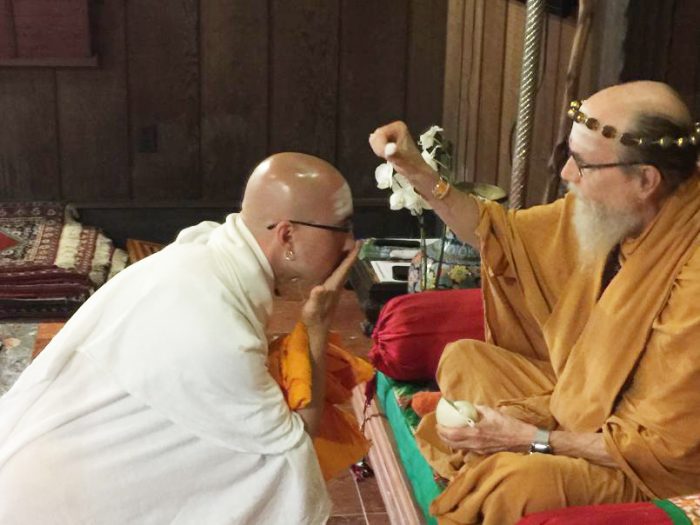As the oldest religion known to humans, Hinduism has had thousands of years to explore meaning and purpose.
The art of understanding the complexities of human nature have been recorded in the Vedas and Agamas—Hinduism’s catechism, poetry, doctrines, commandments, and postulations.
Considered as revealed truth, the hundreds of thousands of pages that comprise the Vedas and Agamas give answers to questions that people throughout time have wondered, and allow questions to form out of critical thinking for every new generation to help answer.
While we all seek to find meaning on Earth, one happens (or stumbles) upon gems of wisdom that they can store for later, experiment with, and see once and for all if this supposed gem of truth can be used in life. Defining three important gems in Hindu thought—grace, darshan, and shakti—is a good start to understanding what this massive and ancient mythology can teach us so that our today can be abundant and fulfilling.
Grace
To understand Eastern thought, and Hinduism specifically, we have to get rid of the idea of sin—original or otherwise.
In Hinduism there is no sin; there’s no hell, eternal damnation, inherent evil, specific path, or ecclesiastical body that condones right from wrong. Even the scriptures are laden with questions instead of answers, sections for critical thought, and praise for the sake of all things being divine.
Hindus believe that no one and no thing is born in sin—what they believe in is grace.
Grace can be thought of as perfection. We are born perfect, without flaw, and heading back to perfection through lessons, sacrifices, and growth—also known as experience. Grace is the Hindu law of perfection that grants everyone access to the most profound truths of existence, so long as they begin the search consciously. You have grace, I have grace, we have grace; and no one is left out. An everlasting divinity abounds in all things everywhere thanks to the Hindu concept and law of grace.
Grace of the guru, or holy ones such as priests, sadhus, renunciates, pundits, and keepers of the traditions in grihasta (householder) life is paramount for inspiration and motivation—a sign that the path still exists—but not essential for “saving.” We all have our own ability to feel, experience, and use grace to our advantage. The key with this idea is that we must be aware of it. Our own ignorance to the divinity and purpose of life is the very cloak that hides the truth. In front of our eyes the whole time, held on to by a rope that we hold, the grace we seek as Hindus is inside us the entire time, as us.
“The man of vision and wisdom sees that eternal spirit hidden in mystery, where the universe lies nestled in His presence. Therein all this comes into being together and therein it falls asunder. Infinite is He, immanent and omnipresent in the created beings.” ~ Yajurveda, Chapter 31
Darshan
Literally meaning, “to be seen,” darshan can be thought of in two ways. One, as conscious thought through sight, or manifestation through being seen or looked at by a temple deity, a divine presence, or a holy person of the faith. And two, a power or force emitting from a powerful source, or emitting out of oneself. This power, both through sight of another and emanation from oneself, is considered a transforming or altering alchemical mixture of wisdom and grace.
Hinduism is not without magic, myth, lore, alchemy, priestly arts, and occult practices. To lay witness to a homa—an attempt to engage with divine presence through fire by recreating space, time, and form cosmogenic ceremony—is to see and feel what ancient culture believed was the answer to divine connection and communication. The result of such tedious and laborious work is darshan, and it goes into the devotee, blessing their path and life. The Hindu seeks darshan from the temple, the guru, and then eventually gives off darshan to those seeking that divine presence from another.
Darshan teaches humility while simultaneously showing that everyone is divine.
When we, as Hindus, look up to another being as greater than us, we are able to quell the ego and nourish our broken or bruised spirits. When the teachings take hold, when our experience outweighs our search, and when we can finally understand the powers of meditation beyond an intellectual level, darshan will be a power of ours to give. Darshan can be seen as an accrual of experience well lived, and an outpouring of wisdom to all that come into contact with us.
Shakti
If you see the sun’s rays piercing through the clouds proclaiming that the heavens are shining down—you are looking at a ray of shakti. Shakti is a force or ray that emits or transfers power from an energy source to its destination. Shakti is why Hindus have a guru, why lineages exist, and how culture, tradition, and sampradaya—religious system—gets passed down from generation to generation.
History’s recreation and cycle of old and new, epochs, schemas, and all things in existence, even things uncreated or not existing anymore, all run on the power of shakti. With shakti, a Hindu can understand the transference of energy and use delicacy and elegance in raising their child, interacting with others, and performing their work while remembering its sacred meaning—to build, create, destroy, and preserve. To us, the Hindu, shakti explains how interacting with other aspects of life creates a boomerang effect of karma.
We give shakti through anger, rage, or disgust. Likewise, when we love, admire, admonish, and praise, we transfer that essence, that shakti, into the subject of our focus.
“The essential nature of awareness is to become one with the object that is deeply contemplated upon. If the yogi meditates continuously on a particular form, he assumes that form in due course. Whichever state of mind is meditated upon, he masters.” ~ Sarvajnanottara Agama, Chapter 7
Explaining the Nature of the World through Eastern Thought
There is a great peace in being able to explain matters of this world, while simultaneously admitting in some cases, “we know not.” There’s nothing wrong with not knowing, just like there’s nothing wrong with knowing.
You don’t need to be a Hindu to live a good life, far from it. A good life consists of truth as you see it. Truth is whatever works in your life at that given moment in time and gives the needed knowledge to endure or thrive for another day. Why would it be otherwise?
In life, we love others, hate others, and learn from others; we disregard, create, preserve creations, destroy those same creations, hide, reveal, get lost, and get found. But, there’s also a before life and after life process—systems of pre- and post-cosmogonic activity. It’s those activities that interest the mystic, the Hindu, and the seeker no matter the background, faith, past, or future.
May this glimpse into the Hindu world be of benefit to you and your journey. I know it has been helpful and meaningful for me.
“When, to one who knows, all beings have verily become one with his own self, then what delusion and what sorrow can be to him who has seen the oneness?” ~ Isha Upanishad
~
Inspired by a conversation with mystic and yogi David Scott.











Read 0 comments and reply